|
Water Management
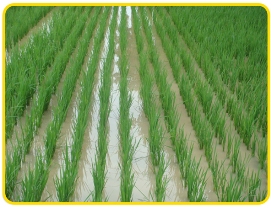 |
| Water Requirement |
|
Crop water requirement is the water required by the plants for its survival, growth, development and to produce economic parts. This requirement is applied either naturally by precipitation or artificially by irrigation.
Average Water requirement – 1100 mm
Average Water requirement (SRI) – 700 mm
The daily consumptive use of rice varies from 6-10 mm and total water is ranges from 1100 to 1250 mm depending upon the agro climatic situation, duration of variety and characteristics of the soils.
|

|
| Stage-wise water requirement for paddy |
| Stages of growth |
Water requirement (mm) |
Precentage of total water requirement |
| Nursery |
40 |
3.22 |
| Main field preparation |
200 |
16.12 |
| Planting to panicle initiation |
458 |
37.00 |
| Panicle initiation to flowering |
417 |
33.66 |
| Flowering to maturity |
125 |
10.00 |
|
Operation wise water requirement of paddy :
| Operation |
Water requirement (mm) |
| Nursery |
40 |
| Land preparation |
200 |
| Field irrigation |
1000 |
| Total |
1240 |
|
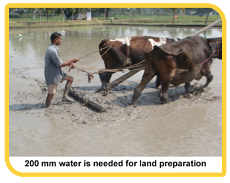 |
| Scheduling of irrigation for paddy |
| Short duration variety |
Medium duration variety |
Long duration variety |
| Days |
No. of irrigation |
Water level
(cm)
|
Days |
No. of irrigation |
Water level
(cm)
|
Days |
No. of irrigation |
Water level (cm) |
| 1-25 |
5-7 |
2-3 |
1-30 |
5-7 |
2-3 |
1-35 |
6-8 |
2-3 |
| 25
|
-
|
Thin film of water
|
30
|
-
|
Thin film of water
|
35
|
-
|
Thin film of water
|
| 28
|
-
|
Life irrigation
|
33
|
-
|
Life irrigation
|
38
|
-
|
Life irrigation
|
| 29-50
|
6
|
2-5
|
34-65
|
6-8
|
2-5
|
39-90 or 95
|
12-15
|
2-5
|
| 51-70
|
5-6
|
2-5
|
66-95
|
8-10
|
2-5
|
96-125
|
7-9
|
2-5
|
| 71-105
|
5-6
|
2-5
|
96-125
|
6-8
|
2-5
|
126-150
|
5-6
|
2-5
|
|
|
| Top |
|
Water Management for Different Ecosystem |
 |
System of Rice Intensification (SRI)
- Irrigation only to moist the soil in the early period of 10 days
- Restoring irrigation to a maximum depth of 2.5cm after development of hairline cracks in the soil until panicle initiation
- Increasing irrigation depth to 5.0 cm after PI one day after disappearance of ponded water.
|
 |
Transplanted lowland rice
- Puddling and leveling minimizes the water requirement
- Plough with tractor drawn cage wheel to reduce percolation losses and to save water requirement up to 20%.
- Maintain 2.5 cm water over the puddle and allow the green manure to decompose for a minimum of 7 days in the case of less fibrous plants like sun hemp and 15 days for more fibrous green manure plants like Kolinchi (Tephrosia purpurea).
- At the time of transplanting, a shallow depth of 2 cm of water is adequate since high depth of water will lead to deep planting resulting in reduction of tillering.
- Maintain 2 cm of water up to seven days of transplanting.
- After the establishment stage, cyclic submergence of water is the best practice for rice crop. This cyclic 5 cm submergence has to be continued throughout the crop period.
- Moisture stress due to inadequate water at rooting and tillering stage causes poor root growth leading to reduction in tillering, poor stand and low yield.
|
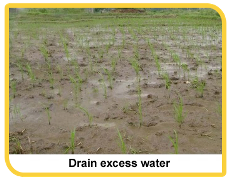 |
Wet Seeded Puddled Lowland Rice
- During first one week just wet the soil by thin film of water.
- Depth of irrigation may be increased to 2.5cm progressively along the crop age.
- Provide adequate drainage facilities to drain excess water or strictly follow irrigation schedule of one day after disappearance of ponded water. Last irrigation may be 15 days ahead of harvest.
|
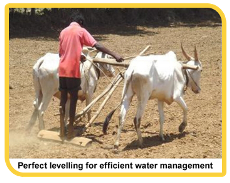 |
Dry Seeded Un-Puddled Rice
- As that of irrigated rice, canal water is used for irrigation
- For drill sown rice care should be taken to drain out excess rain water during first 10-15 DAS and the water level in the field should not be more than 2.5cm height during tillering stage.
- In drill sown rice carry out hodta operation (Planking) in standing water at 40 DAS, and impound sufficient rain water through the crop growth period.
|
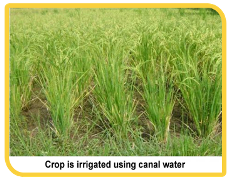 |
Semi-dry rice
- The crop is irrigated from 30-35 days onwards, utilizing water impounded in the tanks.
- Irrigation may be to a depth of 2.5 -5.0cm only. Follow the schedule of one day after disappearance of ponded water in order to save water and to bring additional area under this type of rice cultivation.
|
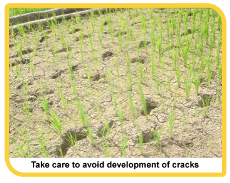 |
Precautions for irrigation (common)
- The field plot can be 25 to 50 cents depending on the source of irrigation.
- Field to field irrigation should be avoided.
- Small bund may be formed parallel to the main bund of the field at a distance of 30 to 45cm within the field to avoid leakages of water through main bund crevices.
- To minimize percolation loss, the depth of stagnated water should be 5cm or less.
- In water logged condition, form open drains, about 60cm in depth and 45cm width across the field.
- Care should be taken not to allow development of cracks.
- In double cropped wetland of command area, raise groundnut / pulse in the place of Kuruvai rice if water is a constraint.
|
|
| Top |
| Critical Stages of Irrigation |
|
The stage at which the water stress causes severe yield reduction is also known as critical stage of water requirement. It is also known as moisture sensitive period.
Critical stages of water requirement in rice are
- Active tillering
- Panicle initiation
- Booting
- Heading and
- Flowering.
During theses stages, the irrigation interval should not exceed the stipulated time so as to cause the depletion of moisture below the saturation level. |
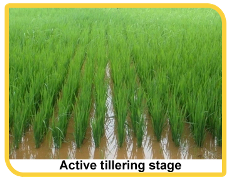
|
|
| Top |
|
Water Management Methods |
 |
Continuous Submergence
- Continuous land submergence for rice is, usually, practiced due to the associated major advantages of increase in availability of nutrients and less weed management problems.
- Shallow submergence of water up to 5 cm depth throughout the crop period is optimum for high yield.
|
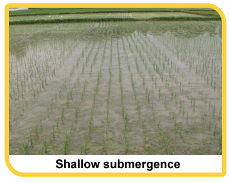 |
Depth of submergence at different stages
Stages of crop growth |
Depth of submergence (cm) |
At transplanting |
2 |
After transplanting for 3 days |
5 |
Three days after transplanting upto maximum tillering |
2 |
At maximum tillering (in fertile fields only) |
Drain water for three days |
Maximum tillering to panicle initiation |
2 |
Panicle initiation to 21 days after flowering |
5 |
Twenty one days after flowering |
Withhold irrigation |
|
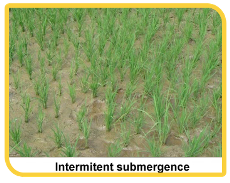 |
Intermittent Submergence
- Continuous land submergence requires huge quantity of water for rice production, so to minimize the irrigation requirement, the approach of intermittent submergence has been practiced.
- Under high humidity and low evaporative demand, the practice of intermittent submergence i.e submergence during the critical stages of crop and maintenance of saturation or drying up to hair cracking stage during the rest of the crop stages.
- Intermittent period varied from one to nine days depending on rainfall pattern, depth of water table and soil texture.
- This practice saves about 30% water.
|
 |
Continuous Flowing Irrigation
- Standing water in lowland rice minimize the irrigation needs leading to high water use efficiency compared with continuous flowing irrigation water from field to field.
- Flowing water from field to field increases grain yield of rice by preventing accumulation of harmful salts in the soil.
- However, nitrogen losses will be higher with continuous flowing irrigation water. Flowing irrigation water is ideal for problem soils.
|
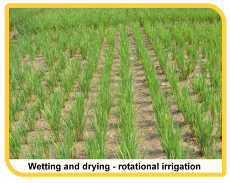 |
Rotational Irrigation
- Required quantity of irrigation water is applied at regular intervals, such that there may not be any standing water in field between two irrigations.
- Irrigation interval is adjusted in such a way that the crop will not experience water deficits at any period.
- It is usually followed at time of deficit water supplies.
- Major advantage of rotational irrigation is possibly the more effective use of rainfall.
- Shallow submergence is advantageous during critical period of the crop
|
|
| Top |
| Components of
Water Losses from Rice Field |
|
The principal losses of water from lowland rice fields can be grouped into two: vapour losses and losses in liquid form.
- Vapour losses are through transpiration from leaf surface and evaporation at water surface collectively referred to as evapotranspiration.
- The two types of liquid losses are deep percolation plus seepage and runoff of excess water over the field levees
|
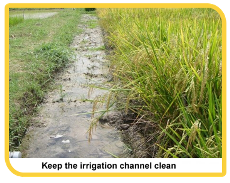 |
Evapotranspiration :
- Evaporation is highest at early growth stages, when the leaf area index (LAI) is small and accounts for most of the evapotranspiration (ET) losses.
- In most of the tropics, the ET requirements during wet season, on an average, is 4-5 mm day -1. During the dry season, it is 8-10 mm day-1.
|
Percolation and seepage:
- Percolation occurs in vertical direction and seepage by horizontal movement through levees.
- Percolation is largely affected by topography, soil characteristics and depth of water table. In a heavy soil with water table close to the soil surface, percolation loss could be around 1.0 mm day-1 as against as high as 10.0 cm day-1 in light soils.
- Seepage, normally, flows into soil surface or streams, rivers or drains, while percolation, usually, contribute to water table.
|
Surface runoff
- It represents a major loss of water in lowland rice production, especially with flowing irrigation water from field to field.
- When the source of irrigation water is wells, there may not be any surface runoff losses.
- Surface runoff losses are most severe in wet season especially at times of high intensity rains.
|
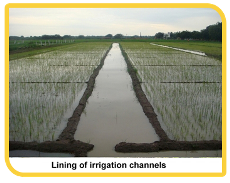 |
Tips to reduce water losses
- Seepage and percolation reduced to considerable extent by intensive land puddling and perfect leveling
- Application of FYM or compost or green manures reduce evaporation, percolation and seepage
- Lining of canals and irrigation channels can be formed to check the seepage.
- Evaporation losses can be minimized by 50% when the soil is kept at saturation under levelled field conditions
- Addition of clay or tank silt (to light textured soils only) @ 150m3/ha reduce the percolation loss by 20 -25%.
- To reduce percolation loss:
- Growing rice in large blocks rather than in isolated small holdings.
- Subsoil compaction
- Rainwater harvesting and levees management can substantially minimize the surface runoff during wet season.
|
|
| Top |
|